 |
| Home for Bats, Raccoons, Squirrels, Bat's or Raccoon's Feces (Guano) Removal, & Wildlife Control . |
| Zip Codes We Provide Services For Counties "A" thru "L" |
| Zip Codes We Provide Services For Counties "M" thru "W" |
| Counties We Provide Service For |
| About Us and Contact Info |
| Bats Found in Ohio |
| Bat Exclusion |
| Guano Removal aka Bat (Feces) Poop |
| Opossums Information on Size, Breeding, Habits, and Diseases |
| Raccoons, Habits, Breeding, Size, Raccoon Diseases, Raccoon Trapping |
| Skunks, Odors, Habit, Breeding, Size, Trapping |
| Squirrels, Squirrel Diseases, Removal, Habits |
| Beavers |
| Chimney & Deck Screening |
| Trapping |
| Common Questions Asked |
| Cats, Dogs and Your Local Wardens |
| Do Repellents Really Work?? |
| My Family's 1st WildlifeTrapper & Home Owner's Insurance |
| Info On Raccoons, Bats, Squirrels, Etc..,Size, Weight, Breeding, Etc... |
| Bats Myths or Facts |
| Infectious Diseases of Wildlife |
| "Ken Kritter Korner" |
|
|
 |

If your home has bats, please be aware that it is imperative that you have them excluded properly and have the home
cleaned properly.
If bats roost in your attic, you need to get them out as quickly as possible. They can cause many problems with smell and parasites as well
Warning
Bats are susceptible to rabies, a serious viral
disease that results in death if untreated. Rabid bats rarely attack humans or other animals, but bats found lying
on the ground may be rabid. Never touch or pick up any bat. Stay away from any animal that seems to be acting strangely and
report it to animal-control officers. If you are bitten by a possibly rabid animal, you must immediately
consult a doctor for a series of injections; there is no cure once symptoms emerge
| Eastern Pipistrelle |
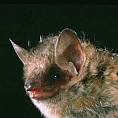
|
| Humeralis |

|
| Little Brown Bat |
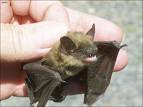
|
| Indiana Bat |
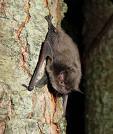
|
Eastern Pipistrelle
- Pipistrellus Subflavus
Common Name: Eastern Pipistrelle Scientific
Name: Pipistrellus Subflavus
Range: Throughout east coast of North America to northern South America
Habitat: Edges of forests and agriculture or watercourses
The Eastern pipistrelle is one of the 11 species
of bats found in Ohio. It is also one of the smallest bats in the east growing up to 3.5" long with a wings span of up to
10" and they can weigh up to 1/4 of an ounce.
Mostly found roosting under loose bark or in the cavity of a tree. However,
they will also be found in buildings. In the winter time they either hibernate living off of stored fat, or they migrate to
warmer climates where food is still available.
Eastern pipistrelles feed on insects, especially leafhoppers, plant hoppers,
moths, beetles, and flies. Usually hunting above the tree canopy they are one of the first bats to emerge in the evening.
They find their food using echolocation.
Bats are the only members of the mammal family that can fly. Like all mammals
they have fur and are warm blooded. They also give live birth and produce milk for their babies. Bats are in the scientific
order Chiroptera (kie-rop-ter-a), which means 'hand-wing' and are known to live from 10 to 32 years.
While most people
generally think of bats living in caves, in the summer time bats actually live behind bark, in tree's, jungles, and man made
structures such as buildings, barns, and bridges.
Bats provide an extremely important service for the environment
in that they eat large quantities insects. In fact some bats can eat as many as 1,200 insects in one hour. Since some insects
such as misquotes carry diseases including the West Nile Virus and other insects like Cucumber Beatles and moths can cause
severe crop damage, bats are doing humans a huge favor as well
Humeralis
Common Name: Evening Bat Scientific Name: Nycticeius Humeralis
Range: Eastern US
The Evening Bat is one of the 11 species of bats found in Ohio. Adults grow to about 4 inches, have a wing span of 11 inches, and weigh about 1/4 ounce.
Evening Bats are insectivore
eating mostly flying insects. Usually hunting above the tree canopy they are one of the first bats to emerge in the evening.
They find their food using echolocation.
Bats are the only members of the mammal family that can fly. Like all mammals
they have fur and are warm blooded. They also give live birth and produce milk for their babies. Bats are in the scientific
order Chiroptera (kie-rop-ter-a), which means 'hand-wing' and are known to live from 10 to 32 years.
Indiana Bat - Myotis Sodalist
Common Name: Indiana Bat Scientific Name: Myotis Sodalis
Range: Eastern US
Is one of the 11 species of bats found in Ohio. Adults
grow to about 3 inches, have a wing span of 10 inches, and weigh about 1/4 ounce. The Indiana Bat is on the U.S. Endangered Species List and classified as endangered throughout its range. States where they are found include AL, AR, GA, IA, IL, IN, KS, KY, MD, MI, MO, MS, NC, NJ, NY, OH, OK, PA, SC, TN, VA, VT, WV.
Indiana Bats are insectivore eating mostly flying insects. Usually hunting above the tree canopy they are
one of the first bats to emerge in the evening. They find their food using echolocation.
Limestone caves are used for winter hibernation. The following caves are
considered Critical habitat in the Southeast: White Oak Blowhole Cave (Blount, TN); Bat Cave (Carter, KY); Coach Cave (Edmonson,
KY).
Bats are the only members of the mammal family that can fly. Like all mammals they have fur and are warm blooded.
They also give live birth and produce milk for their babies. Bats are in the scientific order Chiroptera (kie-rop-ter-a),
which means 'hand-wing' and are known to live from 10 to 32 years.
While most people generally think of bats living in
caves, in the summer time bats actually live behind bark, in tree's, jungles, and man made structures such as buildings, barns,
and bridges.
Little Brown Bat - Myotis Lucifugus
Common Name:
Little Brown Bat
Scientific Name: Myotis Lucifugus
Range: Forested areas of North America
Habitat:Forest areas, often form maternity colonies in buildings, attics
etc..
The Little Brown Bat is one of the 11 species of Bats found in Ohio. Adults
grow to about 3.5 inches, have a wing span of 10 inches, and weigh about 1/4 ounce.
Little Brown Bats are insectivore eating
mostly flying insects. Including beetles, wasps, bees, flies and more. Usually hunting above the tree canopy they are
one of the first bats to emerge in the evening. They find their food using echolocation.
Bats are the only members
of the mammal family that can fly. Like all mammals they have fur and are warm blooded. They also give live birth and produce
milk for their babies. Bats are in the scientific order Chiroptera (kie-rop-ter-a), which means 'hand-wing' and are known
to live from 10 to 32 years.
While most people generally think of bats living in caves, in the summer time bats actually
live behind bark, in tree's, jungles, and man made structures such as buildings, barns, and bridges.
Bats provide an extremely
important service for the environment in that they eat large quantities insects. In fact some bats can eat as many as 1,200
insects in one hour. Since some insects such as misquotes carry diseases including the West Nile Virus and other insects like
Cucumber Beatles and moths can cause severe crop damage, bats are doing humans a huge favor as well.

|
 |
|
| Eastern Red Bat |

|
| Northern long-eared myotis |
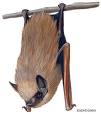
|
| Rafinesgue Big-Eared Bat |

|
| Eastern Smallfooted Myotis |

|
The Eastern Red Bat
(Lasiurus Borealis)
This is
a medium-sized Vespertilionid, averaging weights of 9.5-14 g and measurements of 112.3 mm in total length. Adults are usually
dimorphic: males have red hair while females are chestnut-colored with whitish frosting on the tips of the fur. Like most
Vespertilionids, eastern red bats are insectivorous. Moths (Lepidoptera) form the majority of the diet, but red bats also prey heavily on beetles (Coleoptera), flies (Diptera), and other insects. Echolocation calls have low minimum frequencies, but calls are highly variable ranging from (35-50 kHz).
Eastern red bats are best suited for foraging in open spaces due to their body size, wing shape, and echolocation call structure.
However, red bats are frequently captured by researches foraging over narrow streams and roads
Mating
likely occurs in late summer or autumn and the sperm is stored in the female's reproductive tract until spring when ovulation
and fertilization occurs. In June, females usually give birth to three or four young and then roost with their young until
they are weaned. Males roost alone throughout the Summer. High temperature demands associated with gestation and rearing young
may limit the northern range for reproductive females. Eastern red bats often roost amongst live or dead leaves on the branches
of live hardwood trees, but have also been found using loblolly pine trees in pine plantations
The Eastern Small-Footed Myotis
The Eastern Small-footed Bat is a species of vesper bat in the Vespertilionidae family. It can be found in Ontario and Quebec in Canada and in the eastern United States. It is among the smallest bats in eastern North America.
The Eastern Small-Footed Bat is 65–95 mm
in total length, and weighs between 4–8 grams. It has a 25–45 mm (1–1.75") tail length, has a
210–250 mm (8.3-9.2") wingspan. Like all bats, the Eastern Small-Footed Bat has a flight membrane that connects the body to the forelimbs and
tail, which creates the bats flight. Its ears are under 15 mm (0.6"). Its fur is soft and silky, colored yellowish tan
to golden brown . Its belly is gray, while its face, ears, wings, and interfemoral membrane are black. Its distinguishing characteristics are its black face mask, and its tiny 7–8 mm
(0.3") hind feet.
The Eastern Small-Footed Bat ranges from The Northeastern
United States and Canada down to Georgia and across to Oklahoma.[3]
They are active in mountainous regions from 240
to 1125 meters, preferring deciduous or coniferous forests. They may roost in rock bluffs, buildings, and turnpike tunnels during the spring and summer.
They hibernate during winters in caves and mines, hanging near the opening, or moving deeper as winter temperatures drop.
Little is known about the reproductive habits of the Eastern Small-Footed Bat.[3] Mating usually occurs in Autumn, and the sperm is stored within the female until spring, when fertilization occurs. The offspring are born in late May to July.
Rafinesque's Big-eared Bat
The Rafinesque's Big-Eared Bat (Corynorhinus
rafinesquii) is a species of vesper bat in the Vespertilionidae family that occurs in the southeastern United States, and the states of Texas, Oklahoma, Illinois, Indiana and Ohio..
Corynorhinus rafinesquii is a medium-sized bat
with long rabbit-like ears (27-37 mm). This bat has large facial glands protruding from each side of its snout. Its fur is
grayish brown above and conspicuously bicolored underneath; each individual hair has a dark brown base and whitish tip. Its
long toe hairs extend past the claws. It has a forearm length of 39-43 mm and weighs 7-13 g. The similar Townsend's big-eared
bat lacks contrasting bicolored ventral fur and long toe hairs.
Rafinesque's big-eared bat inhabits forests and
streamside areas throughout the southeastern United States. These agile flyers may be less frequently seen than some other
bats because they leave their roosts only when it is completely dark, forage for insects in the dark, and return to their
roosts before sunrise. Curiously, they prefer roosting in locations that have some amount of light. Their range overlaps that
of several other forest-dwelling bats, such as the eastern pipistrelle, the big brown bat, and some members of the genus Myotis.
Rafinesque's Big-eared Bats are one of the least
known bats in the southeastern United States. Like all bats, big-eared bats help make our lives more comfortable by eating
millions of bugs, especially mosquitoes, every night. This bat uses its big ears and echolocation to help it find food. Because
Rafinesque's Big-eared Bats feed on insects that can be harmful to agriculture, people should treasure this animal. However,
their numbers seem to be declining and they have been listed as threatened since 1977. As people learn more about the role
bats play in managing insect populations, perhaps they will understand the importance of protecting bat roosts. Like all mammals,
bats can contract rabies, but they are no more susceptible to the disease than raccoons, skunks or even dogs. Just like other
animals, bats will bite if they feel threatened. If you find a bat on the ground (rabies immobilizes the animal sometimes),
don't try to help it. Leave it alone and call a game warden. The warden will be able to take care of the animal appropriately.
Roost temperature requirements for maternity colonies, as well as hibernating groups, are poorly understood. Most remaining
colonies live in old buildings that soon may be lost. More detailed knowledge of roost requirements is essential in order
to provide artificial roosts. Feeding habitat requirements also remain poorly documented.
Northern long-eared myotis
Northern long-eared bats (Myotis septentrionalis)
are small bats, typically 5-10 g and 84 mm in total length. The fur is dull brown on the dorsum and yellowish
on the venter. Compared to other Myotis species, these bats have long ears with a relatively long tragus in each ear.
Females give birth to 1 pup each summer and often
form large maternity colonies (30-60 individuals) consisting mainly of females and their young. In the fall, northern long-eared
bats migrate to caves to hibernate. Migration distances are not known for this species. Northerns are often found roosting
singly in caves, rather than in the large clusters typical of other Myotis species, like Myotis sodalis.
Northern long-eared bats are well-suited to foraging
in the forest interior. Echolocation calls have a classic frequency-modulated (FM) structure that allows these bats to navigate
through cluttered environments. Further, their small size allows for more agility in dense vegetation. Long ears allow northerns
to find even stationary insects. Northerns' diets are focused on moths (Lepidoptera), which they often capture by gleaning,
or plucking, the insects from a surface. Gleaning is a unique foraging habit for insectivorous bats since many capture their
prey in flight.
This species is found primarily in coniferous
forest from Newfoundland to the Yukon, and in the southeastern United States through to Florida. Specimens have been found as far west as British Columbia and Texas.
| Hoary Bat |
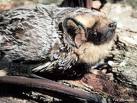
|
| Big Brown Bat |
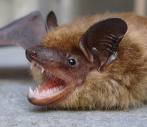
|
| Silver Haired Bat |

|
Silver-Haired Bat - Lasionycteris Noctivagans
A medium-sized, nearly black bat with dorsal surface
of inter femoral membrane densely furred at least on the basal half and usually to near margins; upper and lower parts sooty
brown or black with white tips of hairs producing a frosted appearance; membranes and ears sooty brown or black. External
measurements average: total length, 100 mm; tail, 40 mm; hind foot, 8 mm; ear, 16 mm; forearm, 41 mm. Weight, 8-12 g.
These bats are denizens of forested areas and
seldom are observed in xeric areas except in migration. Cavities in trees and spaces under loose bark are favorite daytime
retreats but these bats may also use buildings. This species is migratory, at least in part. It spends the summer in northern
latitudes and winters toward the south, even crossing several hundred kilometers of ocean to reach Bermuda. Surprisingly few
winter records are available; thus, the mystery of just where these bats spend the winter is still not completely solved.
It is likely that many of them winter on their breeding grounds because occasional individuals have been found hibernating
as far north as New York and British Columbia. Interestingly, most summer records of this bat across the southwest are of
males, suggesting that geographical segregation of the sexes may occur during the warmer months. Females appear to move north
in spring and summer to bear young, whereas the males remain behind at more southern locales.
This bat typically forages in or near coniferous
and/or mixed deciduous forests adjacent to ponds or other sources of water. It is a relatively late flier that often appears
after other bats have begun feeding. As with most other insectivorous bats, Lasionycteris is opportunistic in its feeding
habits and takes a wide variety of small to medium-sized insects including moths, bugs, beetles, flies, and caddisflies.
The one or two young are born in June and July.
Small maternity colonies may form in hollow trees and abandoned bird nests. The young are black and wrinkled at birth and
are able to fly when about 3 weeks old.
Hoary
Bat
A large bat; ears short, rounded, and with black rims; dorsal
surface of membrane between hind legs and feet densely furred; upperparts grayish or brownish, heavily frosted with white;
membranes brownish black except along forearm where they are yellowish. Not easily confused with any other North American
bat. External measurements average: total length, 136 mm; tail, 57 mm; foot, 12 mm; ear, 18 mm; forearm, 52 mm. Weight, 20-35
g.
This bat is migratory and moves northward in spring and southward
in winter. Like its relative the red bat, with which it frequently associates, the hoary bat is more or less solitary and
frequents wooded areas where it roosts in the open by hanging from a branch or twig. It is a strong flier, and in association
with other bats it is readily recognized by its large size and swift, erratic flight. This bat usually emerges rather late
in the evening, but during migration it frequently is observed in daylight hours.
The chief food is moths, although they are known to also eat
beetles, flies, grasshoppers, termites, dragonflies, and wasps. Apparently, the hoary bat feeds by approaching a flying moth
from the rear, engulfing the abdomen-thorax, and then biting down, allowing the sheared head and wings to drop to the ground
The usual number of young is two but ranges from one to four
and parturition occurs in mid-May into early July.
Big
Brown Bat
The Big Brown Bat (Eptesicus fuscus) is larger in size than
comparative species of bats, from about 4 to 5 inches (10 – 13 cm) in body length, with a 11-13 inch wingspan and weighing
1/2 to 5/8 ounce. The fur is moderately long, and shiny brown. The wing membranes, ears, feet, and face are dark brown to
blackish in color.
This species is normally a forest dweller, but it does not
hesitate to utilize attics and crevices in buildings, caves, and crevices in rocks for daytime retreats. Favorite roosts are
under the loose bark of dead trees and in cavities of trees. These bats emerge rather early in the evening and feed among
the trees, often following a regular route from one treetop to another and back again. In contrast to red bats (Lasiurus borealis), big brown bats prefer to forage among the crowns of the trees rather than under the forest
canopy. Their flight is relatively slow and direct. Big brown bats are relatively ferocious when captured.
They usually squeal when handled and produce a rapid ratchet like sound; they continually try to bite and usually draw blood
when they succeed in doing so. They cannot produce a serious wound, however. In the water they swim well, but they cannot
take off from the surface as can some of the smaller bats (Myotis and Pipistrellus). In winter they migrate or seek hibernation quarters in caves or buildings.
Their food is entirely insects, which they capture in flight.
Fecal pellets of these bats have shown that they feed on beetles, bees and their allies, flies, stone flies, May flies, true
bugs, nerve-wings, scorpion flies, caddisflies, and cockroaches. Peculiarly, moths are seldom found. Food items vary, of course,
from one region to another.
These bats mate in the fall, and the one or two young are born
from May to August. Four embryos have been found in a female, but it is unlikely that they all would have survived because
the mother has only two teats. Big brown bats in the eastern part of the United States usually produce two young per litter,
whereas in the Rocky Mountains and westward only one young is produced.
At birth, the young bats weigh about 3.0 g and grow quickly,
gaining as much as 0.5 g per day. Maternity colonies are often located in buildings and may contain from 20 to 300 individuals.
Adult males usually are not present in maternity colonies until the young mature, when they may begin using maternity colonies
more frequently. At 4 weeks of age the young bats begin foraging for themselves and reach adult size approximately 2 months
after birth.
Click Here To Read About Bat Exclusion
Click Here to Learn About Guano Removal
Please
remember when dealing with a Wildlife problem, it is always advisable to contact a professional, such as ourselves, for
Safety and Health Reasons before you attempt to resolve any problem that might be present. When dealing with the exclusion
of bats it is advisable to hire a professional who will be able to remove ALL THE BATS without danger to you, secure your residence, sanitize the
area affected, and if needed remove and replaced your contaminated insulation. Remember that your dealing
with a WILD ANIMAL and your health and your families health
MUST BE
your 1st concern.
|
 |
|
|
 |
|
|
 |
|
|
|
|
|
|
 |

